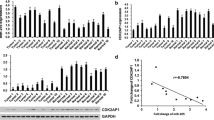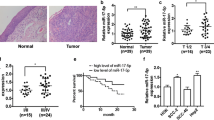Abstract
MicroRNAs (miRNAs) have been recognised to regulate cancer development and progression in carcinogenesis as either oncogenes or tumour suppressor genes. However, whether miR-203 plays a crucial role in human laryngeal squamous cell carcinoma (LSCC) remains largely unclear. In the study, we have found that miR-203 expression was significantly lower in LSCC tissues than that in corresponding adjacent non-neoplastic tissues and was negatively correlated with ASAP1 expression level. Lower expression of miR-203 was significantly related to poor differentiation, advanced clinical stages, T3–4 tumour grade, lymph node metastasis and decreased 5-year overall survival. Transfection with miR-203 inhibited proliferation, reduced invasion, induced apoptosis and caused G1 phase cell cycle arrest of Hep-2 cells in vitro, suggesting that miR-203 functioned as a tumour suppressor. We have also tested that over-expression of miR-203 may both suppress the growth of xenograft tumours in mice and downregulate the expressions of ASAP1 in vivo. Furthermore, miR-203 may regulate the expressions of mesenchymal transition (EMT) marker of E-cadherin and cancer stem cells (CSCs) marker of CD44. These findings suggest that miR-203 plays a role as a tumour suppressor in LSCC, likely by regulating ASAP1, probably in relation to EMT and CSCs and may serve as a potential target for therapeutic intervention.







Similar content being viewed by others
References
Chu EA, Kim YJ. Laryngeal cancer: diagnosis and preoperative work-up. Otolaryngol Clin N Am. 2008;41:673–95.
Siegel R, Ward E, Brawley O, Jemal A. Cancer statistics, 2011: the impact of eliminating socioeconomic and racial disparities on premature cancer deaths. CA Cancer J Clin. 2011;61:212–36.
Wang W, Lin P, Han C, Cai W, Zhao X, Sun B. Vasculogenic mimicry contributes to lymph node metastasis of laryngeal squamous cell carcinoma. J Exp Clin Cancer Res. 2010;29:60–9.
Pillai RS, Bhattacharyya SN, Artus CG, Zoller T, Cougot N, Basyuk E, et al. Inhibition of translational initiation by Let-7 microRNA in human cells. Science. 2005;309:1573–6.
Ruvkun G. Clarifications on miRNA and cancer. Science. 2006;311:36–7.
Lewis BP, Burge CB, Bartel DP. Conserved seed pairing, often flanked by adenosines, indicates that thousands of human genes are microRNA targets. Cell. 2005;120:15–20.
Calin GA, Dumitru CD, Shimizu M, Bichi R, Zupo S, Noch E, et al. Frequent deletions and down-regulation of micro-RNA genes miR15 and miR16 at 13q14 in chronic lymphocytic leukemia. Proc Natl Acad Sci U S A. 2002;99:15524–9.
Bentwich I, Avniel A, Karov Y, Aharonov R, Gilad S, Barad O, et al. Identification of hundreds of conserved and non-conserved human microRNAs. Nat Genet. 2005;37:766–70.
Griffiths-Jones S, Grocock RJ, van Dongen S, Bateman A, Enright AJ. miRBase: microRNA sequences, targets and gene nomenclature. Nucleic Acids Res. 2006;34:D140–4.
Sassen S, Miska EA, Caldas C. MicroRNA: implications for cancer. Virchows Arch. 2008;452:1–10.
Yi R, Poy MN, Stoffel M, Fuchs E. A skin microRNA promotes differentiation by repressing ‘stemness’. Nature. 2008;452:225–9.
Lena AM, Shalom-Feuerstein R, et al. MiR-203 represses ‘stemness’ by repressing DeltaNp63. Cell Death Differ. 2008;15:1187–95.
Iorio MV, Visone R, Di Leva G, Donati V, Petrocca F, Casalini P, et al. MicroRNA signatures in human ovarian cancer. Cancer Res. 2007;67:8699–707.
Ikenaga N, Ohuchida K, Mizumoto K, Yu J, Kayashima T, Sakai H, et al. MicroRNA-203 expression as a new prognostic marker of pancreatic adenocarcinoma. Ann Surg Oncol. 2010;17:3120–8.
Mathé EA, Nguyen GH, Bowman ED, Zhao Y, Budhu A, Schetter J, et al. MicroRNA expression in squamous cell carcinoma and adenocarcinoma of the esophagus: associations with survival. Clin Cancer Res. 2009;15:6192–200.
Kozaki K, Imoto I, Mogi S, Omura K, Inazawa J. Exploration of tumour-suppressive microRNAs silenced by DNA hypermethylation in oral cancer. Cancer Res. 2008;68:2094–105.
Di Leva G, Croce CM. Roles of small RNAs in tumor formation. Trends Mol Med. 2010;16:257–67.
Ren J, Zhu D, Liu M, Sun Y, Tian L. Downregulation of miR-21 modulates Ras expression to promote apoptosis and suppress invasion of laryngeal squamous cell carcinoma. Eur J Cancer. 2010;46:3409–16.
Zhang T, Liu M, Wang C, Lin C, Sun Y, Jin D. Down-regulation of MiR-206 promotes proliferation and invasion of laryngeal cancer by regulating VEGF expression. Anticancer Res. 2011;31:3859–63.
Furuta M, Kozaki KI, Tanaka S, Arii S, Imoto I, Inazawa J. miR-124 and miR-203 are epigenetically silenced tumour-suppressive microRNAs in hepatocellular carcinoma. Carcinogenesis. 2010;31:766–76.
Saini S, Majid S, Yamamura S, Tabatabai L, Suh SO, Shahryari V, et al. Regulatory role of mir-203 in prostate cancer progression and metastasis. Clin Cancer Res. 2011;17(16):5287–98.
Czernilofsky AP, Levinson AD, Varmus HE, Bishop JM, Tischer E, Goodman HM. Nucleotide sequence of an avian sarcoma virus oncogene (src) and proposed amino acid sequence for gene product. Nature. 1980;287:198–203.
Viticchiè G, Lena AM, Latina A, Formosa A, Gregersen LH, Lund AH, et al. MiR-203 controls proliferation, migration and invasive potential of prostate cancer cell lines. Cell Cycle. 2011;10:1121–31.
Randazzo PA, Inoue H, Bharti S. Arf GAPs as regulators of the actin cytoskeleton. Biol Cell. 2007;99:583–600.
Jones CA, Nishiya N, London NR, Zhu W, Sorensen LK, Chan AC, et al. Slit2-Robo4 signalling promotes vascular stability by blocking Arf6 activity. Nat Cell Biol. 2009;11:1325–31.
Hashimoto A, Hashimoto S, Ando R, Noda K, Ogawa E, Kotani H, et al. GEP100-Arf6-AMAP1-cortactin pathway frequently used in cancer invasion is activated by VEGFR2 to promote angiogenesis. PLoS One. 2011;6(8):e23359.
Müller T, Stein U, Poletti A, Garzia L, Rothley M, Plaumann D, et al. ASAP1 promotes tumor cell motility and invasiveness, stimulates metastasis formation in vivo, and correlates with poor survival in colorectal cancer patients. Oncogene. 2010;29:2393–403.
Lin D, Watahiki A, Bayani J, Zhang F, Liu L, Ling V, et al. ASAP1, a gene at 8q24, is associated with prostate cancer metastasis. Cancer Res. 2008;68:4352–9.
Sarrio D, Palacios J, Hergueta-Redondo M, Gomez-Lopez G, Cano A, Moreno-Bueno G, et al. Functional characterization of E- and P-cadherin in invasive breast cancer cells. BMC Cancer. 2009;9:74.
Huber MA, Kraut N, Beug H. Molecular requirements for epithelial-mesenchymal transition during tumor progression. Curr Opin Cell Biol. 2005;17:548–58.
Lombaerts M, van Wezel T, Philippo K, Dierssen JW, Zimmerman RM, Oosting J, et al. E-cadherin transcriptional downregulation by promoter methylation but not mutation is related to epithelial-to-mesenchymal transition in breast cancer cell lines. Br J Cancer. 2006;94:661–71.
Liu X, Wang C, Chen Z, Jin Y, Wang Y, Kolokythas A, et al. MicroRNA-138 suppresses epithelial-mesenchymal transition in squamous cell carcinoma cell lines. Biochem J. 2011;440(1):23–31.
Cheng W, Liu T, Wan X, Gao Y, Wang H. MicroRNA-199a targets CD44 to suppress the tumorigenicity and multidrug resistance of ovarian cancer-initiating cells. FEBS J. 2012;279(11):2047–59.
Zhao H, Ma B, Wang Y, Han T, Zheng L, Sun C, et al. miR-34a inhibits the metastasis of osteosarcoma cells by repressing the expression of CD44. Oncol Rep. 2013;29(3):1027–36.
Naor D, Wallach-Dayan SB, Zahalka MA, Sionov RV. Involvement of CD44, a molecule with a thousand faces, in cancer dissemination. Semin Cancer Biol. 2008;18:260–7.
Acknowledgments
The research was supported by grants from the Heilongjiang Postdoctoral Fund (LBH-Z12157), the foundation of Heilongjiang Educational Committee (12531343), the foundation of Heilongjiang Health Bureau (2012–624), the National Science Foundation of China (81241085, 81372902), the key project of Natural Science Foundation of Heilongjiang Province of China (ZD201215/H1302), the Research Fund for the Doctoral Program of Higher Education of China (20102307110007) and the Science and Technology Innovation Talent Research funds of Harbin (2012RFXXS072).
Conflicts of interest
None
Author information
Authors and Affiliations
Corresponding authors
Additional information
Linli Tian and Minghua Li are first co-authors.
Rights and permissions
About this article
Cite this article
Tian, L., Li, M., Ge, J. et al. MiR-203 is downregulated in laryngeal squamous cell carcinoma and can suppress proliferation and induce apoptosis of tumours. Tumor Biol. 35, 5953–5963 (2014). https://doi.org/10.1007/s13277-014-1790-7
Received:
Accepted:
Published:
Issue Date:
DOI: https://doi.org/10.1007/s13277-014-1790-7




